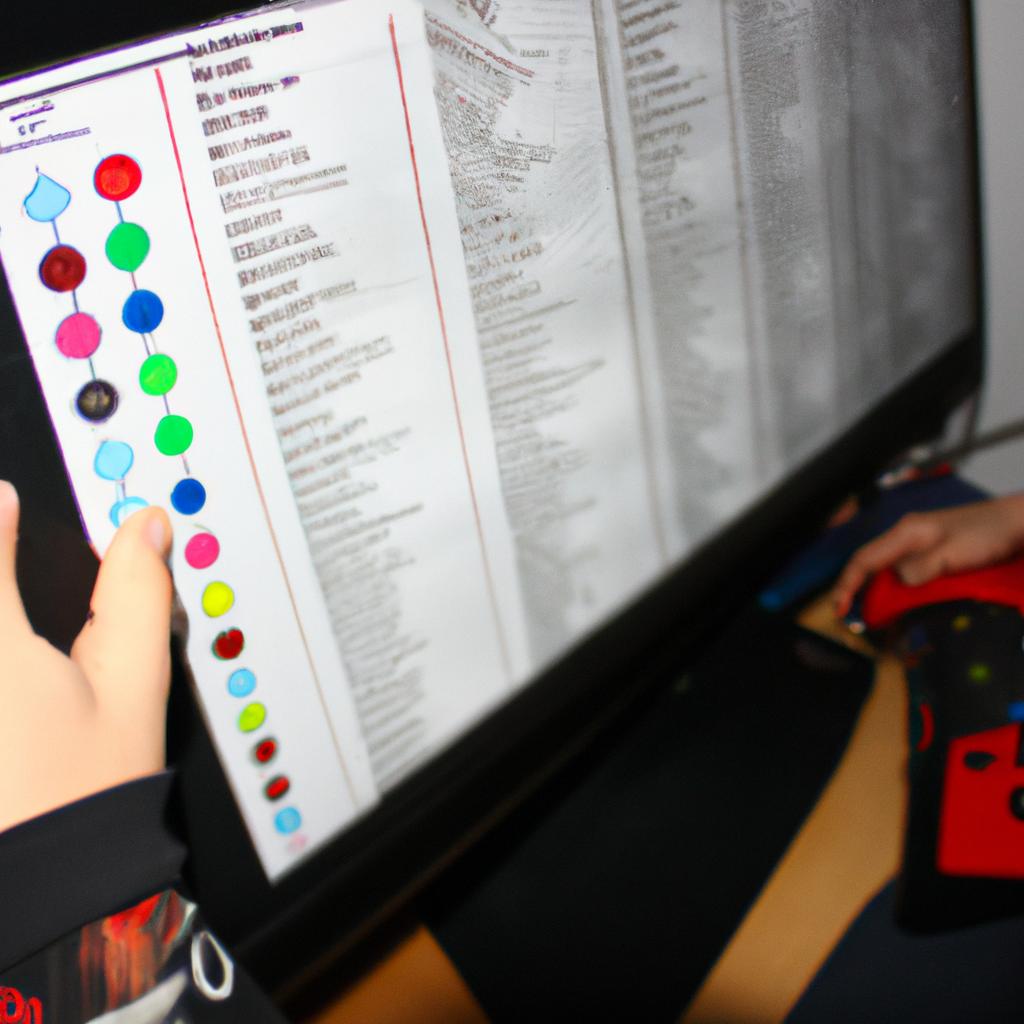Game Development: A Comprehensive Guide to Games and Video Games

The world of game development has rapidly evolved over the years, encompassing a wide range of creative and technological advancements. From simple board games to immersive virtual reality experiences, the landscape of gaming has expanded exponentially. This comprehensive guide aims to provide an in-depth exploration into the fascinating realm of game development, shedding light on its various aspects and intricacies.
Consider a hypothetical scenario where a team of talented developers embarks on a mission to create an innovative video game that takes players on an adventure through ancient civilizations. In order to bring this vision to life, they must meticulously plan each step of the process – from conceptualizing characters and storyline to designing captivating visuals and implementing complex gameplay mechanics. Such is the journey undertaken by game developers, combining artistry with technical expertise to craft engaging experiences for millions of players worldwide.
Throughout this article, we will delve into the fundamental concepts behind game development, exploring topics such as game design principles, programming languages used in creating games, storytelling techniques employed in narrative-driven titles, and emerging trends in the industry. By understanding these crucial elements, aspiring developers can gain valuable insights into the intricate craftsmanship required to produce successful games. Additionally, readers will be introduced to key considerations when developing for different platforms and target audiences while also examining ethical implications within the gaming industry.
Ethical implications within the gaming industry have become increasingly important as games continue to reach larger and more diverse audiences. Developers must consider factors such as inclusivity, diversity, representation, and responsible monetization practices. Inclusivity involves ensuring that games are accessible to players of all backgrounds and abilities, including options for different languages, subtitles, colorblind modes, and customizable controls. Diversity encompasses the representation of various cultures, genders, sexual orientations, and ethnicities within game content to promote inclusivity and avoid perpetuating harmful stereotypes.
Another ethical consideration is responsible monetization practices. This refers to the way developers implement in-game purchases or microtransactions without exploiting players or creating a pay-to-win environment. It is crucial for developers to strike a balance between providing optional additional content while also ensuring fair gameplay for all players.
Additionally, ethical concerns may arise in relation to data privacy and security when it comes to online multiplayer games or games that collect personal information from players. Developers must prioritize protecting user data and being transparent about how it is used.
By addressing these ethical considerations during game development, developers can create an inclusive and responsible gaming experience that respects the rights and well-being of players.
Different Approaches to Creating Games
When it comes to creating games, developers have a myriad of approaches at their disposal. Each approach offers unique advantages and challenges, making the decision process an important aspect of game development. To illustrate this point, let’s consider the case study of a hypothetical indie developer named Alex.
Alex is passionate about developing a new puzzle game for mobile devices. As Alex begins exploring different approaches, several options come to mind:
- In-house Development: This involves building the game entirely in-house with a team of dedicated developers. It provides full control over every aspect of the game but requires significant time and resources.
- Outsourcing: Alternatively, Alex could outsource certain aspects of game development such as artwork or programming tasks to external professionals or studios. This option allows for specialized expertise while reducing the workload on the core team.
- Collaborative Development: In this approach, Alex can partner with other individuals or teams who share similar aspirations and skills to develop the game together. Collaborative development fosters creative synergy and distributed responsibilities among team members.
- Game Engine Utilization: Another possibility is leveraging existing game engines like Unity or Unreal Engine. These engines provide pre-built tools and frameworks that expedite development processes and enable more efficient resource allocation.
To better understand these different approaches, let us examine them through a comparative lens using the following table:
| Approach | Advantages | Challenges |
|---|---|---|
| In-house Development | Full control over all aspects | Time-consuming and resource-intensive |
| Outsourcing | Access to specialized expertise | Coordination with external entities |
| Collaborative Development | Creative synergy from diverse perspectives | Potential conflicts within the team |
| Game Engine Utilization | Streamlined development processes | Learning curve for working with engines |
By carefully considering these various approaches, Alex can make an informed decision regarding the best methodology for developing their puzzle game. The subsequent section will explore how to choose the right approach based on specific factors and requirements.
In light of this exploration into different approaches, it is crucial for developers like Alex to carefully consider each option’s advantages and challenges before embarking on a particular path. By doing so, they can make an educated choice that aligns with their goals and resources while ensuring efficient and successful game development.
Choosing the Right Methodology for Game Development
In the previous section, we explored various approaches that game developers can take when creating games. Now, let us delve deeper into the importance of choosing the right methodology for game development.
To better understand this concept, let’s consider a hypothetical scenario involving a team of indie game developers who are working on their first project. They have limited resources and need to make strategic decisions to ensure the success of their game. This example will serve as our guiding case study throughout this section.
When it comes to selecting a methodology for game development, there are several factors that should be taken into consideration:
- Scope: The size and complexity of the project play a crucial role in determining the most suitable approach. For instance, if our indie team aims to create a small-scale mobile game with minimal features, an Agile methodology like Scrum could be an excellent choice due to its flexibility and iterative nature.
- Team Size and Expertise: The number of team members involved and their level of experience also influence which methodology is best suited for the project. In our case study, since our indie team consists of only three members with diverse skill sets but limited expertise in game development, they might benefit from using a method like Waterfall or Kanban that provides more structure and guidance.
- Time Constraints: Deadlines often drive decision-making in any project, including game development. If time is of the essence for our indie team because they want to release their game before a specific event or convention, they may opt for Rapid Application Development (RAD) or Lean methodologies that emphasize speedy delivery without compromising quality.
- Creative Freedom vs. Control: Another aspect to consider is striking a balance between creative freedom and control over the development process. Some teams prefer methodologies like Extreme Programming (XP), which encourage collaboration, experimentation, and adaptability – ideal for those seeking innovation at every step. Conversely, other teams may prefer a more structured approach, such as the Waterfall methodology, to maintain better control over each stage of development.
By carefully evaluating these factors and aligning them with their project’s specific needs, our indie team can make an informed decision on which methodology will best suit their game development journey. Understanding the significance of choosing the right approach is crucial for any developer seeking success in this competitive industry.
In the upcoming section, we will explore the role of game engines in creating games and how they contribute to the overall development process. So let us now transition into understanding how game engines shape the world of game creation.
Understanding the Role of Game Engines
Having understood the importance of selecting the right methodology for game development, let us now delve into gaining a deeper understanding of the role played by game engines in this process.
Game engines are software frameworks that facilitate the creation and development of games. They provide developers with an array of tools, libraries, and components essential for building interactive experiences. To illustrate their significance, consider a hypothetical scenario where a team of developers is tasked with creating a 3D action-adventure game set in a post-apocalyptic world. Without a robust game engine at their disposal, they would face numerous challenges such as implementing Realistic physics simulations, handling complex animations, and managing audio effects seamlessly throughout the gameplay experience.
- Simplify Development Process: Game engines streamline the development process by providing pre-built functionalities that can be customized to suit specific requirements.
- Enhance Cross-platform Compatibility: With support for multiple platforms like PC, consoles, and mobile devices, game engines enable developers to reach wider audiences.
- Optimize Performance: Through efficient resource management techniques and built-in optimization features, game engines help ensure smooth and responsive gameplay.
- Enable Iterative Prototyping: By offering rapid prototyping capabilities, game engines empower developers to iterate on ideas quickly and refine their design choices based on user feedback.
| Key Features | Engine A | Engine B | Engine C |
|---|---|---|---|
| Real-time Physics | Yes | No | Yes |
| Visual Scripting | No | Yes | Yes |
| Multiplayer Support | Yes | No | Yes |
| Mobile Platform | Android/iOS | iOS/Android | Android Only |
In conclusion,
As we have explored the role played by game engines in game development, it is now time to shift our focus towards exploring various graphics techniques employed in games.
Exploring Various Graphics Techniques in Games
In the previous section, we explored how game engines play a crucial role in the development of video games. Now, let’s delve deeper into this topic and examine some key aspects that make game engines an indispensable tool for developers.
One example that highlights the significance of game engines is the popular game “Fortnite” developed by Epic Games. This multiplayer online battle royale game relies on Unreal Engine, a widely-used game engine known for its advanced graphics capabilities and robust physics simulation. The success of Fortnite not only demonstrates the impact of a powerful game engine but also showcases how it can elevate gameplay experiences to new heights.
When it comes to understanding the role of game engines, several important factors come into play:
- Graphics Rendering: Game engines provide sophisticated rendering techniques that bring virtual worlds to life. From realistic lighting effects to detailed textures, these tools enable developers to create visually stunning environments.
- Physics Simulation: Accurate physics simulation is essential for creating immersive gameplay mechanics. Game engines offer built-in physics systems that allow objects within the game world to interact realistically with each other and respond to external forces.
- Audio Integration: Sound plays a vital role in enhancing player immersion and setting the mood in games. Modern game engines often include audio middleware solutions that simplify sound design and integration processes.
- Cross-Platform Compatibility: With players accessing games across various devices, compatibility becomes paramount. Game engines facilitate multi-platform deployment, enabling developers to reach wider audiences without extensive rework.
These features collectively contribute to engaging gameplay experiences that captivate players’ imaginations and emotions.
| Feature | Description | Benefit |
|---|---|---|
| Advanced Rendering | Realistic visuals enhance immersion and improve overall aesthetic quality | Enhanced visual experience |
| Robust Physics | Accurate object interactions create dynamic gameplay scenarios | Engaging and challenging gameplay |
| Seamless Audio | High-quality sound integration adds depth and enhances immersion | Enhanced player experience |
| Multi-platform Support | Ability to deploy games on multiple platforms, expanding the reach of the game | Wider audience accessibility |
As we continue our exploration into the world of game development, it is important to acknowledge how game engines have evolved over time. The next section will delve into the fascinating realm of graphics techniques in games, where we will discuss various approaches used by developers to create stunning visual experiences. This evolution has been closely intertwined with advancements in another crucial aspect of gaming: artificial intelligence.
The Evolution and Impact of Artificial Intelligence in Gaming
Building upon the importance of graphics in games, let us delve deeper into the multitude of techniques that game developers employ to create visually stunning and immersive experiences. By employing advanced graphics techniques, developers can bring virtual worlds to life, captivating players and enhancing their overall gaming experience.
One example of a technique used is ray tracing. This rendering method simulates the behavior of light by tracing rays from the viewer’s perspective and calculating how they interact with objects in the scene. By accurately modeling reflections, refractions, and shadows, ray tracing adds a level of realism previously unseen in video games. For instance, imagine playing an open-world racing game where you see realistic reflections of your car on wet asphalt or accurate shadows cast by trees along the track.
To further enhance visuals, developers often utilize post-processing effects such as motion blur and depth-of-field. These techniques add depth and cinematic quality to gameplay by emulating real-life camera effects. Imagine navigating through a dense forest in a survival horror game; with motion blur applied when sprinting between trees, the sense of speed intensifies while maintaining focus on key elements within the environment.
Incorporating cutting-edge graphics technology requires significant computational power but results in breathtaking visual fidelity that captivates players’ emotions:
- High-resolution textures transport players into highly detailed environments.
- Dynamic lighting creates atmospheric moods that influence player perception.
- Realistic physics simulations drive immersion by enabling believable interactions.
- Advanced particle systems breathe life into scenes through vibrant explosions or flowing waterfalls.
| Technique | Description | Emotional Response |
|---|---|---|
| Ray Tracing | Creates lifelike reflections and shadows for heightened realism | Awe |
| Post-processing Effects | Adds cinematic quality; immerses players with film-like visuals | Excitement |
| High-resolution Textures | Enhances detail; transports players to intricately designed worlds | Wonder |
| Dynamic Lighting | Sets the mood and atmosphere of a scene, influencing player emotions | Suspense |
As game developers continue to push the boundaries of what is visually possible, it becomes evident that graphics play an integral role in captivating players. However, visuals alone are not enough to create a truly immersive experience. Next, we will explore how artificial intelligence has evolved within gaming and its profound impact on gameplay.
Mastering Game Physics for Realistic Gameplay
Continuing our exploration of the fascinating world of game development, let us now delve into the realm of artificial intelligence (AI) and its profound impact on gaming. To illustrate this influence, consider a hypothetical scenario: imagine playing a strategy game where you challenge an AI opponent with seemingly human-like decision-making abilities. As you strategize your moves, the AI acts intelligently to counter your tactics, adapt to unpredictable situations, and even anticipate your next move. Such is the power of AI in modern games, revolutionizing not only player experiences but also shaping the future landscape of gaming.
Artificial intelligence has become increasingly sophisticated over time, enabling developers to create virtual characters that exhibit complex behaviors and interact with players on multiple levels. Whether it’s non-player characters (NPCs) simulating realistic social interactions or enemies adapting their strategies based on player behavior, AI adds depth and immersion to games. This integration allows for dynamic gameplay scenarios that keep players engaged while providing unique challenges tailored to their individual skill level.
To better understand the impact of AI in gaming, let us explore some key aspects:
- Adaptive Difficulty Levels: AI algorithms can analyze player performance and adjust difficulty levels accordingly. This ensures that gamers are consistently challenged without feeling overwhelmed or bored.
- Realistic NPCs: Advanced AI techniques enable NPCs to exhibit emotions, make decisions based on simulated thought processes, and engage in meaningful conversations with players.
- Dynamic Environments: With intelligent systems controlling environmental elements like weather patterns or enemy encounters, games can offer ever-changing landscapes that respond dynamically to player actions.
- Enhanced Player Immersion: By creating believable worlds filled with intelligent inhabitants who react realistically within their respective contexts, AI elevates the overall immersion factor for players.
Furthermore, we can examine how different genres benefit from these advancements by looking at a comparison table:
| Genre | Traditional Gameplay | Gameplay with AI |
|---|---|---|
| First-Person | Linear enemy behavior | Adaptive enemies that learn and adapt to player strategies |
| Role-Playing | Predefined character interactions | NPCs with dynamic personalities and realistic decision-making |
| Strategy | Static opponent patterns | AI opponents capable of strategic planning and adaptation |
| Simulation | Rule-based simulations | Complex, evolving ecosystems |
As we can see from the example above, incorporating AI into game development has transformed traditional gameplay experiences. The evolution of artificial intelligence in gaming continues to push boundaries, offering players more immersive and engaging encounters.
Transitioning seamlessly into our next section on “Building Engaging Multiplayer Experiences,” let us explore how multiplayer features have evolved alongside advancements in AI. By combining intelligent systems with social interaction elements, developers are creating shared gaming experiences that captivate players around the world.
Building Engaging Multiplayer Experiences
Imagine a hypothetical scenario where you are playing a video game that has stunning graphics, intricate gameplay mechanics, and an immersive storyline. However, as you progress through the game, you find yourself overwhelmed by the complexity of its design. The multitude of options, controls, and objectives make it difficult to navigate and enjoy the experience fully. This example highlights the importance of striking a balance between complexity and simplicity in game design.
To create engaging multiplayer experiences, developers need to consider various factors that can influence player satisfaction and enjoyment. Here are some key aspects to keep in mind:
-
Clarity of Objectives:
- Clearly define goals for players to achieve.
- Provide intuitive visual cues or indicators to guide them towards these objectives.
- Avoid overwhelming players with excessive information or convoluted instructions.
-
Accessibility:
- Ensure that your game is accessible to gamers of all skill levels.
- Implement adjustable difficulty settings or adaptive gameplay mechanics.
- Offer optional tutorials or hints to assist new players without hindering experienced ones.
-
Streamlined User Interface (UI):
- Design a clean and user-friendly UI layout.
- Minimize clutter by prioritizing essential information on-screen.
- Utilize clear icons, tooltips, or hover-over explanations to aid understanding.
-
Balanced Learning Curve:
- Gradually introduce new concepts and mechanics throughout the game’s progression.
- Allow players time to master existing skills before introducing more complex challenges.
- Maintain a sense of challenge while avoiding frustration or monotony.
Striking the right balance between complexity and simplicity can greatly enhance the overall gaming experience. By considering these aspects during development, developers can create games that captivate both casual players seeking accessibility and seasoned gamers craving depth.
Transitioning into the subsequent section about “Balancing Complexity and Simplicity in Game Design,” we delve further into the intricate art of creating games that provide an enjoyable experience for all players, regardless of their skill level or prior gaming experience.
Balancing Complexity and Simplicity in Game Design
Section: Balancing Complexity and Simplicity in Game Design
In the pursuit of creating captivating gaming experiences, striking a balance between complexity and simplicity is crucial for game designers. By carefully managing the level of intricacy within gameplay mechanics and systems, developers can ensure that players are both challenged and engaged with the game. This section will explore the importance of finding this delicate equilibrium by examining key considerations and strategies.
To illustrate this concept, let’s consider the popular role-playing game “FantasyQuest.” In FantasyQuest, players embark on epic adventures in a vast open world filled with quests, monsters, and treasures. The game offers an extensive skill tree system where players allocate points to various attributes such as strength, agility, and magic. However, too much complexity can overwhelm players who may struggle to understand how each attribute affects their character’s abilities or progress through the game.
Maintaining a balanced design requires careful attention to several factors:
- Clarity: Ensuring that gameplay mechanics and instructions are easy to comprehend enhances player satisfaction.
- Progression: Gradually introducing new features allows players to learn at their own pace without feeling overwhelmed.
- Depth: Providing deeper layers of strategy or customization options appeals to more experienced players seeking challenge.
- Accessibility: Striving for a design that accommodates different skill levels broadens the potential audience for a game.
| Feature | Description | Emotional Response |
|---|---|---|
| Immersive | Captivating storyline & rich environments | Excitement |
| Rewarding | Satisfying achievements & progression | Motivation |
| Challenging | Difficult but achievable goals | Determination |
| Creative | Opportunities for personalization | Engagement |
Finding harmony between complexity and simplicity is no easy task for game designers. It involves analyzing target audiences’ preferences while considering technical constraints. By integrating these considerations into the game design process, developers can strike a balance that caters to both casual and hardcore gamers alike.
Transitioning smoothly into the subsequent section on “Optimizing Performance for Smooth Gaming,” designers must also ensure that their games run efficiently without sacrificing visual quality or functionality.
Optimizing Performance for Smooth Gaming
Transitioning smoothly from the previous section on balancing complexity and simplicity in game design, we now turn our attention to another crucial aspect of game development: optimizing performance for smooth gaming. To illustrate this concept, let us consider a hypothetical scenario where a popular open-world role-playing game experiences frequent frame rate drops and lag during intense combat sequences. Players find these technical issues frustrating, as they disrupt their immersion in the game world and hinder their overall experience.
To address such performance challenges, developers employ various strategies that allow games to run smoothly even on less powerful hardware configurations or under high computational demands. Here are some key considerations:
-
Efficient Rendering Techniques:
- Implement level-of-detail (LOD) systems to dynamically adjust the detail of objects based on player proximity.
- Utilize occlusion culling techniques to only render what is visible within the camera’s view frustum.
- Employ texture streaming to load textures progressively, reducing memory usage and improving loading times.
- Optimize shader code by minimizing unnecessary calculations and leveraging GPU capabilities effectively.
-
Resource Management:
- Use efficient data structures like spatial partitioning or quad/octrees for fast collision detection and object lookups.
- Stream assets intelligently during gameplay to reduce load times and memory footprint.
- Employ memory pooling techniques to reuse resources instead of constantly creating and destroying them.
- Develop smart AI algorithms that strike a balance between responsiveness and resource consumption.
-
Code Optimization:
- Profile the game regularly using specialized tools to identify bottlenecks in CPU or GPU usage.
- Optimize critical sections of code through parallelization or algorithmic improvements.
- Minimize draw calls by batching rendering operations whenever possible.
- Apply suitable compression techniques for asset files without sacrificing visual quality excessively.
By implementing these optimization practices, developers can ensure smoother gameplay experiences for players across different platforms and hardware configurations. With careful consideration of performance constraints, game designers can focus on creating immersive and engaging worlds that captivate their audience.
Transitioning seamlessly into the subsequent section about “Creating Immersive Visuals and Audio in Games,” we delve deeper into the realm of sensory experiences within video games.
Creating Immersive Visuals and Audio in Games
In the previous section, we explored techniques to optimize game performance and ensure smooth gameplay. Now, let’s delve into another critical aspect of game development: creating immersive visuals and audio in games.
Imagine a player stepping into a virtual world filled with stunning landscapes, realistic characters, and captivating sound effects. To achieve this level of immersion, developers employ various strategies that enhance both the visual and auditory aspects of their games.
One example of how visuals can be optimized is through efficient texture mapping. By carefully managing textures used in 3D models, developers can reduce memory consumption while maintaining high-quality graphics. This optimization technique allows for smoother rendering and improved overall performance.
To further elevate the gaming experience, designers consider incorporating visually appealing effects such as particle systems or dynamic lighting. These elements add depth and realism to the virtual environment by simulating natural phenomena like fire, raindrops, or shadows moving across surfaces.
When it comes to audio design, spatial sound is an essential tool for enhancing immersion. Through careful placement of sounds within a game’s environment using surround sound technology or binaural recording techniques, players are fully enveloped in their virtual surroundings.
Now let’s explore some key factors that contribute to achieving truly immersive visuals and audio:
- High-resolution textures and detailed character models
- Dynamic lighting and advanced shading techniques
- Realistic physics simulations for objects and environments
- Carefully crafted soundscapes that complement the on-screen action
Table: Factors Contributing to Immersive Visuals and Audio
| Factor | Description |
|---|---|
| High-resolution textures | Textures with fine details provide more realistic appearance |
| Dynamic lighting | Changing light sources create a sense of dynamism in the scene |
| Physics simulations | Accurate object interactions enhance realism |
| Rich soundscapes | Layered audio tracks and spatial sound placement immerse players in the game world |
By incorporating these factors into their games, developers create experiences that truly captivate players’ senses.
As visuals and audio work together to bring virtual worlds to life, another crucial aspect of game development lies in crafting compelling narratives that draw players deeper into the gaming experience.
Incorporating Storytelling in Game Narratives
In the previous section, we explored the importance of creating immersive visuals and audio in games. Now, let’s delve into some key techniques that can help game developers achieve this goal.
One example of a game that excels in creating an immersive experience is “The Witcher 3: Wild Hunt” developed by CD Projekt Red. The game immerses players in its rich fantasy world through stunning visuals and atmospheric sound design. By meticulously crafting detailed environments, realistic character models, and breathtaking special effects, the developers were able to transport players into a believable and captivating virtual realm.
To create truly immersive visuals and audio in games, consider implementing the following strategies:
- Harnessing the power of modern graphics engines such as Unreal Engine or Unity to render lifelike environments with high-quality textures, lighting effects, and particle systems.
- Utilizing dynamic sound systems that adapt to player actions or environmental changes to enhance realism and immersion.
- Incorporating advanced animation techniques like motion capture for more fluid character movements.
- Paying attention to small details such as ambient sounds, background music, voice acting, and interactive elements within the game world.
Here is a table showcasing how these techniques contribute to enhancing immersion in games:
| Techniques | Benefits | Examples |
|---|---|---|
| High-quality graphics | Visually appealing; enhances realism | Realistic landscapes |
| Dynamic sound systems | Creates a sense of presence | Reactive soundtrack |
| Advanced animations | More lifelike characters | Natural-looking movements |
| Attention to details | Heightens overall immersion | Interactive environment |
By incorporating these techniques into game development practices, developers have the potential to captivate players on a deeper emotional level, making their gaming experiences much more memorable.
As we move forward into the next section on testing and debugging strategies for game development, it is essential to ensure that the immersive visuals and audio created are not compromised. By employing effective testing methodologies, developers can guarantee a seamless experience for players from start to finish.
Next section: Testing and Debugging Strategies for Game Development
Testing and Debugging Strategies for Game Development
Building an engaging narrative is a crucial aspect of game development. Once the story has been incorporated into the game, developers must then shift their focus towards testing and debugging strategies to ensure a smooth gameplay experience.
Imagine launching a highly anticipated video game only to encounter numerous bugs and glitches that hinder your progress or even crash the entire game. Such experiences can be frustrating for players and detrimental to the success of the game itself. Therefore, thorough testing and effective debugging strategies are essential in the realm of game development. This section will explore some common approaches used by developers to identify and fix issues within their games.
Testing Techniques:
To ensure the quality of a game, developers employ various testing techniques throughout its production process. These techniques include:
- Functional Testing: Verifying that all aspects of the game function as intended.
- Compatibility Testing: Ensuring compatibility across different platforms and hardware configurations.
- Performance Testing: Assessing how well the game performs under various conditions (e.g., heavy graphical effects or high player traffic).
- User Acceptance Testing (UAT): Involving actual users to test the game’s usability, identifying potential improvements.
Table – Common Types of Testing:
| Test Type | Purpose | Examples |
|---|---|---|
| Functional Testing | Verify all functionalities work correctly | Verifying controls, character movements |
| Compatibility Testing | Ensure compatibility across platforms | Checking performance on PC, console versions |
| Performance Testing | Assess performance under different conditions | Evaluating frame rate during intense scenes |
| User Acceptance Testing (UAT) | Evaluate user satisfaction with gameplay | Gathering feedback from beta testers |
Debugging Strategies:
When issues arise during testing, skilled developers rely on efficient debugging strategies to identify and resolve them promptly. Some commonly employed methods include:
- Logging: Implementing detailed logs to track program execution and identify potential errors.
- Code Review: Conducting thorough reviews of the game’s codebase to catch any logical or syntactical issues.
- Step-by-step Debugging: Systematically stepping through the code, examining variables and their values at each step for anomalies.
Testing and debugging are integral parts of the game development process. By employing various testing techniques and effective debugging strategies, developers can enhance player experience, reduce frustration caused by bugs, and ensure that their games meet high standards of quality. With attention to detail in these areas, developers can create immersive gaming experiences that captivate players from start to finish.









